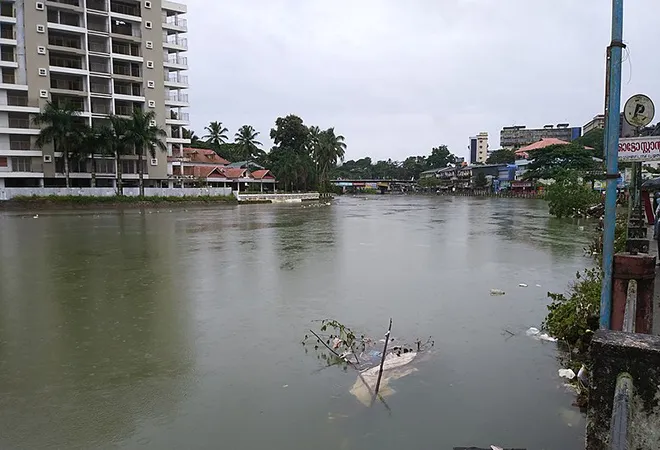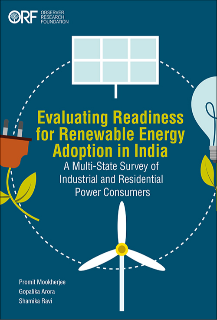
Indian cities lack basic urban infrastructure planning. Most cities have grown over time with little or no planning. Even new millennium cities like Gurgaon are poorly planned. They have no public transport, poor street lighting, high crime, poor policing, bad roads and they inevitably flood during heavy rainfall due to poor state of drains. India’s capital city New Delhi and the business capital Mumbai are also devastated every monsoon creating chaos, water logging and traffic jams. The city infrastructure in most cases is inadequate to bear the daily urban load. This is true from Ladakh to Kanyakumari, from Kutch to Changlang. Disaster management is neither available nor ever planned for. Rural India does not have even the unplanned infrastructure that cities have.
Kerala is similar to most other states. The streets of Kochi or Kottayam are no different than any other two tier or three tier city of India. Narrow, busy and choking. Despite huge forex remittances from its expat population and tourism dollars, Kerala has failed to invest into modern city or rural infrastructure. Like most other Indian states infrastructure is pretty ordinary. Costal cities like Busan in South Korea and San Francisco in California are developed with detailed disaster risk management plans. Like most coastal cities they are prone to typhoons and cyclones, flooding and earthquakes. They have advanced flood forecasting techniques and use underground tanks, submersible pumps, levees, stream gates to handle such eventualities. Indian coastal towns have no such preparedness and usually a two-day warning by IMD to manage the fury of nature.
Fishermen and civilians pitched in
On Monday, 6 August 2018, the IMD issued an Orange Alert forecasting heavy rains in Kerala for a week. Torrential rains hit the State next day and on the 9th as the Aluva Mahadeva temple in Kochi was seen submerged in water due to flash floods. The IMD Red Alert followed. By Saturday, 11 August, 34 people had died from flash floods and eight districts of the 15 in the State were declared flood hit . The Kerala State Disaster Management Authority swung into action and 31,000 people were evacuated and sent to rescue camps. On Sunday, 12 August, Home Minister Rajnath Singh flew in to take stock of the situation. Things were happening quicker than usual and seamlessly without the press making headlines about tardy relief work.
During the Cyclone Ockhi that hit the coastal districts of Kerala and Tamilnadu in 2017, hundreds of fisherman had joined the Navy and the Coastguard in rescue operations. The fishermen again entered the rescue mission using local knowledge of habitats and understanding of the rivers to their advantage. Being locals they came first even before the NDRF and the army took charge. They used a few hundred twin engined locally designed fishing boats that can move in shallow waters (less than 2 feet deep) and restrictive spaces and can evacuate ten persons at a time. Working with the local authorities, volunteer groups and the police, they rescued hundreds of people stranded in their homes as the floodwaters rose. The people and the state worked in tandem, a rare sight for an Indian State in crisis. It was great to see not only the activists but the citizens involved in relief work.
Dam politics was inevitable but needless
The State started monitoring 44 rivers of the State which were in spate and ordered opening of gates of 25 water reservoirs initially to avoid major damages to the dams. Opening flood gates during heavy rains is very controversial and was more so when the neighbouring State Tamil Nadu opened the gates of the Mullaperiyar dam. But that had to be raised because the Iduki dam shutters were lifted after 26 years by the KSEB as the massive reservoir became full. The release of water from Idduki was planned a fortnight before the disaster, but done at the last minute. The Idukki dam, the Cheruthoni dam and the Mullaperiyar dam are part of a very complex ecosystem and the Idukki dam is more than 6 times bigger than the Mullaperiyar.
Also people forgot that on 11 January 2018, the Supreme Court had directed both States to set up a separate subcommittees under the Disaster Management Act for flood water management. Neither State took action. More rain, and the situation on ground worsened by 13 August. What had started as heavy rains in the Western Ghat area and northern Kerala spread to the entire State. By then, all the dams of the State had opened their floodgates to ensure that the dams don’t break.
Post flood rescue was exemplary
The National Disaster Response Force flew in 58 rescue teams in one of the largest rescue missions conducted in the decade. Each team had 30 to 40 trained personnel and were completely equipped with necessary gear, equipment and pre-hospitalisation medicines to carry out their mission. Before the Independence Day, large parts of Thrissur, Alappuzha, Ernakulam and half a dozen other districts were under water. Over 10,000 people were evacuated each day to relief camps as rains kept pounding the State. The pace of rescue work was unprecedented.
The Army, Airforce and the Navy stepped into the rescue mission with their own teams. They airlifted stranded people, and built temporary bridges for evacuation. Thousands were rescued during a 24 x 7 operations that lasted over a week. The Southern Naval Command deployed 92 teams with Gemini boats and seamen accompanied by expert divers from the Navy for the search and rescue operations. Around 15,000 people have been rescued by the Navy boats, and over 600 stranded people airlifted by choppers and flown to relief camps.
The airforce flew in specialists and relief supplies as the commercial flights were unable to land in the flooded airports. They used their superior knowledge of logistics and helped maintain the supply lines for relief and rescue. Restoring power and water supply and communication was the task of the engineering wing of the army. Medical teams and supplies were flown in from Maharashtra and several neighbouring States by the Airforce. The Army, Navy and Airforce have always been at the forefront of rescue operations and this time it was no different. What was different this time was that the people also joined hands proactively.
Timely relief without pilferage
Relief camps across the State were pretty organised. They were well stocked and orderly. There was no reports of relief material being misappropriated. All operations were transparent, quick and without corruption or mismanagement which was unique. Monetary aid came in from all over the country, including from the Malayali diaspora located all over the world. The Prime Minister, Mr. Narendra Modi, visited Kerala on 17 August and sanctioned an additional grant of Rs 500 crore for relief and rehabilitation. True there was a lot of politics and bad blood in the media, but it did not affect relief operations. The rain Gods finally relented after ten days on 18 August and sun finally shone on the God’s own country, but not before leaving 483 dead and over 15 lakhs rescued and evacuated, in relief camps and other places.
The rescue and relief work over, the people of the state and the Government have to deal with rehabilitation of thousands, after the most devastating flood in 100 years. This was possibly the first time a massive disaster in India was really well managed. Many people owe credit for this massive combined effort but what this shows is that we are steadily becoming responsible to relief and rescue work like in the mature democracies. It is heartening to see that there were no reports of diversion of goods, pilferage of citizens wealth, irresponsibility of aid givers and lack of food, beds, blankets and medicines at relief centres. A lot of challenges remain like fighting water borne diseases, breakout of rat fever and several others.
The biggest challenge will be of rebuilding homes and more aid is expected from the Central Government as well as citizens. The silver lining at last was that we were able to manage disasters efficiently and clinically, like most developed nations do.
The views expressed above belong to the author(s). ORF research and analyses now available on Telegram! Click here to access our curated content — blogs, longforms and interviews.




 PREV
PREV


